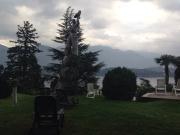A great lunch with the Bundestagspräsident, a former Ministerpräsident of Rheinland-Pfalz and Thüringen (Bernhard Vogel), a French theologian and a Jewish academic – we discussed the NSA revelations, spying on Merkel, the Holocaust and other things – and then back to work.
Wo Sprache endet: Das Verhältnis von Literatur, Transzendenz und Politik was a paper delivered by Professor Dr Lydia Koelle (Bonn). I expected some sort of treatment similar to that by Rowan Williams in his book on 'Dostoyevsky: Language, Faith & Fiction', but what we got didn't seem to address the theme of the title. However, it led to a good question about the transference of 'trauma' from a generation of Germans who did not 'live' the Holocaust, but reads 'trauma' back into an experience that was not actually lived as a trauma by those who actually went through it. (I might be doing this session an injustice, but it was the post-lunch slot and we had wine with lunch…)

Zwischen Medialisierung, Religionskonflikt und Rückkehr der Figuration: Religion in der Kunst am Beginn des 21. Jahrhunderts saw Dr Johannes Rauchenberger (Graz, Austria) illustrate how contemporary morally-challenging events are handled in art – for example, Razoume (?) on the recent Lampedusa migration deaths.
Ulrich Khuon, Intendant of the Deutsches Theater in Berlin, was really interesting about theater and film as he addressed the theme Glaube, Welt und die Kunst des Spiels: Kino und Theater als Seismographen der Gegenwart. He began with Pasolini observing Jesus from a distance in his 'Gospel of St Matthew', then ranged widely around Friedrich Schiller, Mallick and Julian Barnes in relation to death, suffering and the human condition.
Zwischen Skandal und neuer Kunstreligion: Das zwiespältige Verhältnis von Künsten und Religion in der Öffentlichkeit, an exploration of how art provokes and challenges, saw Professor Dr Wolfgang Ullrich (Staatliche Hochschule für Gestaltung, Karlsruhe) tackle public responses to (a) Gerhard Richter's east window in Cologne Cathedral, and (b) Martin Kippenberger's 'Crucified Frog'. Both caused huge controversy: the former because it subverts both the architctural form and the received nature/purpose of stained-glass windows in churches, and the latter for obvious reasons. The window substitutes traditional biblical images with 11,500 four-inch 'pixels' cut from original antique glass in a total of 72 colours, dividing opinion between those (like the bishop) who hate it and those who say that “all the saints, all the parables, every thought, every idea, transcendence itself are all here in these windows”. Richter observed that the critical bishop had actually understood it: [it is] “gar nicht katholisch.”
Interestingly (and pertinently), the symposium has heard no reference in today's papers to music – a surprising omission. Mind you, there isn't time to cover everything…
I need dinner…

